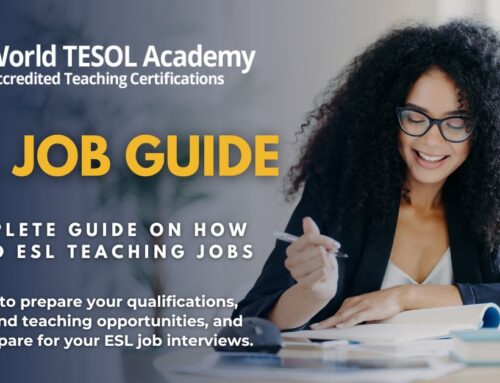
The ESL Teacher’s Social Media Guide
In today’s digital age, establishing a strong online presence has become increasingly important for professionals in all fields, including ESL teachers. Social media platforms offer valuable opportunities to connect with colleagues and students, share resources, and find exciting new job opportunities.
By effectively harnessing the power of these platforms, ESL teachers will have access to a range of tools that can help expand their networks, enhance their professional development, and make a lasting impact in the field of education. But how do you approach professionally using social media as an ESL teacher, and what should you keep in mind when selecting platforms and building your brand?
In this blog post, we will explore the key benefits of building a professional online presence as an ESL teacher, as well as provide practical tips on how to leverage social media to boost your teaching career.
Key benefits of utilizing social media for ESL teachers
Social media platforms have transformed the way we communicate and connect with others. ESL Teachers nowadays are just one click away from sharing and gaining access to ESL content and opportunities from all over the world. This means that if you utilize these platforms effectively, you are able to greatly enhance your professional growth and career.
Let’s start by taking a look at the key benefits that social media can bring to English teachers across the globe.
🫱🫲 Networking and collaboration
Social media platforms such as LinkedIn, Twitter, and Facebook provide opportunities to easily connect with fellow ESL teachers, educational organizations, and experts in the field. Engaging in online communities allows for sharing ideas, resources, and best practices which in turn can foster collaboration and professional growth.
💼 Job hunting
Social platforms are often used by recruiters to post job offerings to ESL teachers around the world. This makes social platforms a great tool to include in your job hunt if you wish to find more opportunities online and overseas.
📑 Resource sharing
Social media platforms are also a treasure trove for educational resources. ESL teachers can create, discover and share lesson plans, teaching materials, and educational tools with a global community of like-minded educators.
📈 Brand building
Leveraging social media is a great way to build up your brand and reach new potential students, especially if you are working as a private tutor. By establishing an active and engaging online presence you are able to build up credibility and value as an expert in your field which in turn can help expand your student network and boost your chances when applying for teaching positions.
👔 Professional development
Through social media, ESL teachers can also get exposed to a wealth of professional development opportunities. They can find communities and specialists that offer webinars and online courses, expanding their knowledge and honing their skills at their convenience.
Become TESOL/TEFL certified:
Being able to show your audience that you possess the necessary qualifications to professionally teach English online and overseas is key if you wish to build a successful online presence and credibility within the ESL field.
To achieve this, you’ll need to have an accredited and recognized TESOL/TEFL certificate.
If you haven’t enrolled in the 120-hour TESOL/TEFL course, you can do so here:
.

Choosing the right social media platforms
With a plethora of different social media platforms available, it’s essential to carefully choose the ones that align with your professional goals and target audience, as not all platforms are used for the same purposes. Doing so will allow you to create and share content that is relevant to your audience and the platform, as well as maximize the impact it has on your brand-building efforts.
Popular platforms among ESL teachers:
Instagram: Instagram is a good resource for sharing visual content, especially teaching tips and shorter videos related to teaching. It’s also a great way to create an online teacher profile that can be used to market yourself as a teacher, as well as connect, network, and collaborate with fellow ESL teachers.
YouTube: YouTube is great for sharing longer video content such as classroom activity demonstrations, teaching technique tips, and language learning videos for English learners. It’s also a convenient way to share your pre-recorded introduction and demo class video.
Facebook: Facebook is an excellent resource for finding job and networking opportunities within the ESL industry. By searching for Facebook groups that focus on ESL teaching, you are able to find a myriad of job postings from recruiters all over the world. There are also plenty of groups that focus on resource and advice sharing from experienced teachers.
LinkedIn: LinkedIn is a platform that is geared towards professionals, and it offers ESL teachers a great opportunity to create a professional online profile that can be used to showcase your experience and expertise via an online resume. It’s also useful for connecting with employers and finding job opportunities within the ESL industry.
Twitter: Twitter is a platform that allows you to engage in educational conversations with fellow colleagues, influential educators and organizations from around the world. By using hashtags you are able to easily find and follow interesting conversations and networking opportunities.
Pinterest: Pinterest is a fantastic platform for sharing ESL resources such as lesson plans and teaching materials. This turn can help build credibility and authority within the ESL field and provide you with alternative career opportunities, such as working with curriculum and material development.

Best practices for utilizing social media
To build an effective online presence that can help boost your ESL teaching career, you should consider the following best practices:
🎯 Define your goals: Identify your professional objectives and target audience. Determine what you want to achieve through your online presence, such as sharing teaching strategies, connecting with fellow educators, showcasing your expertise, or finding new students.
👩🏫 Showcase your expertise: Share educational content that is relevant, informative, and engaging. This can include blog posts, articles, videos, infographics, and other curated resources. Aim to provide value to your audience and spark meaningful conversations which can help build your brand as an ESL teacher.
💬 Engage with your audience: Actively participate in discussions, respond to comments, and ask thought-provoking questions. Engaging with your audience fosters connections, builds credibility, and expands your network.
🔑 Consistency is key: Regularly post content to maintain visibility and relevance. Develop a consistent content schedule that works for you, ensuring a steady flow of valuable information for your audience. It’s better to focus on posting a moderate volume of content consistently rather than posting a high volume spontaneously and inconsistently.
👔 Maintain professionalism: Remember that your online presence represents your professional identity and is an extension of your brand. Be mindful of the content you share, use proper grammar and language, and maintain a respectful approach and tone in all interactions.
📊 Utilize data: It’s important to collect and analyze user data from your audience, as it will allow you to see who is engaging with you, and which type of content is performing well. There are several tools that you can use for this such as Google Analytics, Meta Business Suite, etc.
🔒 Privacy and security: Familiarize yourself with each platform’s privacy settings and adjust them according to your comfort level. Be cautious about sharing personal information and carefully research the content you engage with as careless conduct can come back to bite you.
🤵 Online etiquette: Maintain professional conduct online. Be respectful, considerate, and mindful of others’ perspectives, and don’t publicly bad-mouth competitors or people you may disagree with on certain topics. Remember that your interactions reflect on your professional image.
🧠 Information overload: With the vast amount of content available online, it’s easy to get overwhelmed and lose sight of your professional goals. Tailor your social media feeds by following reputable accounts and organizations that align with your interests and professional goals.
.
It’s good to keep in mind that the best practices provided above are just general guidelines that you can use to help you get started. As you build your online presence and brand, you should regularly go over your strategy and make adjustments based on the data you receive from the platforms.
Conclusion
Which social media platform to use and what strategy to adopt, can vary greatly depending on your goals and audience. By utilizing the correct platforms effectively, ESL teachers can build a strong online presence that opens doors to networking, collaboration, and professional growth. Whether it’s sharing resources, engaging with other users, or showcasing your expertise, harnessing the power of social media can greatly enhance your brand as an ESL teacher and help make your mark in the global ESL community.




Leave A Comment